医学药理学英文名词解释
药理学名词解释
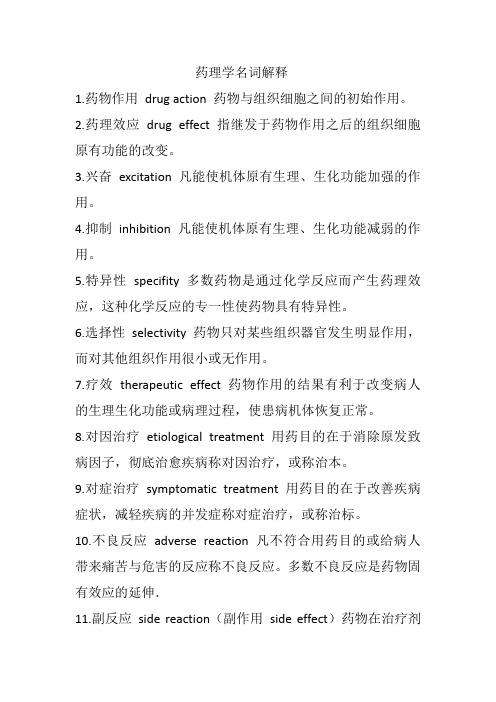
药理学名词解释1.药物作用drug action 药物与组织细胞之间的初始作用。
2.药理效应drug effect 指继发于药物作用之后的组织细胞原有功能的改变。
3.兴奋excitation 凡能使机体原有生理、生化功能加强的作用。
4.抑制inhibition 凡能使机体原有生理、生化功能减弱的作用。
5.特异性specifity 多数药物是通过化学反应而产生药理效应,这种化学反应的专一性使药物具有特异性。
6.选择性selectivity 药物只对某些组织器官发生明显作用,而对其他组织作用很小或无作用。
7.疗效therapeutic effect 药物作用的结果有利于改变病人的生理生化功能或病理过程,使患病机体恢复正常。
8.对因治疗etiological treatment 用药目的在于消除原发致病因子,彻底治愈疾病称对因治疗,或称治本。
9.对症治疗symptomatic treatment 用药目的在于改善疾病症状,减轻疾病的并发症称对症治疗,或称治标。
10.不良反应adverse reaction 凡不符合用药目的或给病人带来痛苦与危害的反应称不良反应。
多数不良反应是药物固有效应的延伸.11.副反应side reaction(副作用side effect)药物在治疗剂量时出现的与治疗目的无关的作用称副反应,亦称副作用。
副反应是药物本身固有的,是因药物选择性低而引起的,一般不严重,难避免。
12.毒性反应toxic reaction 药物在剂量过大、用药时间过长、机体敏感性过高时对机体发生的危害性反应称毒性反应。
一般较严重,但是可以预知和避免。
13.后遗效应residual effect 停药后血药浓度已降至阈浓度以下时残存的药理效应。
14.停药反应withdrawal reaction 长期应用某些药物,突然停药后原有病情加重现象。
又称回跃反应(rebound reaction)15.变态反应allergic reaction(过敏反应hypersensitive reaciton)药物对过敏特质病人引起的异常免疫反应。
药理学名词解释(含英文)

1.药物(drug)是指能够影响机体(包括病原体)功能和(或)细胞代活动,用于疾病的治疗、预防和诊断,以及计划生育等方面的化学物质。
1.Drugs are chemicals that alter the function of living systems by interactionsat the molecular level and can be used to prevent, diagnose and treat disease.2.不良反应(adverse drug reaction ADR)是指上市的合格药品在常规用法、用量情况下出现的,与用药目的无关,并给患者带来痛苦或危害的反应。
3.副作用(side effect)是由于药物作用选择性低,作用围广,在治疗剂量引起的,与用药目的无关的作用。
4.毒性反应(toxic effect)是由于用量过大或用药时间过长引起的严重不良反应。
5.后遗效应(residual effect)是指在停药后,血浆药物浓度下降至阈浓度以下时残存的药理效应。
6.变态反应(allergic reaction)是药物引起的免疫反应,反应性质与药物原有效应无关,其临床表现包括免疫反应的各种类型。
致敏原可以是药物本身或药物代产物,亦可能是制剂中的杂质或辅剂。
7.继发反应(secondary reaction)是继发于药物治疗作用之后的不良反应。
8.停药反应(withdrawal reaction)是指患者长期应用某种药物,突然停药后发生病情恶化的现象。
9.特异质反应(idiosyncrasy reaction)是指少数患者由于遗传因素对某些药物的反应性发生了变化。
特异质反应表现为对药物的反应特别敏感,或出现与在常人不同性质的反应。
10.依赖性(dependence)是药物与机体相互作用所造成的一种状态,表现出强迫要求连续或定期使用该药的行为或其他反应,其目的是感受药物的精神效应,或避免由于停药造成身体不适应。
药理学名词解释大全

药理学名词解释大全1. 药理学(Pharmacology):研究药物在生物体内的作用机制和药理效应的科学。
2. 药物(Drug):可通过口服、注射、外用等途径作用于生物体的物质,能改变生理或病理状态。
3. 药效学(Pharmacodynamics):研究药物在生物体内的作用机制及其所产生的效应的学科。
4. 药代动力学(Pharmacokinetics):研究药物在生物体内的吸收、分布、代谢和排泄等过程的学科。
5. 生物利用度(Bioavailability):指药物经口或其他非静脉给药途径后,在生物体内被吸收的比例。
6. 抗生素(Antibiotic):一类可以抑制或杀死细菌的药物。
7. 耐药性(Drug Resistance):指细菌、病毒等生物对药物的抵抗能力。
8. 毒理学(Toxicology):研究药物和其他化学物质对生物体的毒性及其发生机制的学科。
9. 激动剂(Agonist):一种能够结合到受体并引起生物体产生反应的药物。
10. 拮抗剂(Antagonist):一种能够与受体结合,但不引起生物体产生反应的药物。
11. 副作用(Side Effect):药物除了期望的治疗效果外,还会引起其他的不良效应。
12. 受体(Receptor):生物体体内一种特异性分子,能与药物结合,传递或阻断特定的信号。
13. 作用靶点(Target):药物在生物体内所作用的分子或结构。
14. 治疗指数(Therapeutic Index):一种衡量药物安全性的指标,即药物的治疗剂量与产生毒性副作用的剂量之比。
15. 组织亲和力(Tissue Affinity):药物在体内特定组织中的浓度和细胞内的作用效果。
16. 细胞毒性(Cytotoxicity):药物对体内细胞的有害作用。
17. 缓释剂(Sustained-Release Agent):一种控制药物在体内释放速率的物质。
18. 单剂毒性(LD50):指在短时间内,将试验动物的毒物剂量为体重的平均值,能在一半的试验动物中引起死亡的剂量。
药理学名词解释

药理学名词解释1、药理学(pharmacology):就是研究药物与机体(包括病原体)之间相互作用及作用规律得一门学科.2、药效学(pharmacodynamics):研究药物对机体得作用与作用机制。
3、药动学(pharmacokinetics):研究药物在机体得影响下所发生得变化及其规律,包括吸收、分布、代谢与排泄等过程。
4、离子障(iontrapping):药物在跨膜转运时,非离子型(非解离部分)药物可以自由穿透,而离子型药物就被限制在膜得另一侧。
5、首关消除(firstpassmetabolism):口服药物从胃肠道吸收后经门静脉进入肝脏,有些药物易被肝脏截留破坏(代谢),进入体循环得有效药量明显减小。
6、药酶诱导剂:有些药物能增强药酶活性或使药酶合成加速,从而加快其本身或另一些药物转化,使其作用减弱或缩短。
7、肝肠循环(enterohepatic cycle):有些药物在肝细胞与葡萄糖醛酸等结合后排入胆中,随胆汁到达小肠后被水解,游离药物被重吸收,此过程称为肝肠循环。
8、一级动力学消除(first—order elimination kineti cs):又称恒比消除,就是体内药物在单位时间内消除得药物百分率不变。
9、零级动力学消除(zero—order elimination kinetics):又称恒量消除,就是药物在体内以恒定得速率消除。
10、稳态血药浓度(steady—state concentration,Cs s):也称坪值.按照一级动力学规律消除得药物,其体内药物总量随着不断给药逐步增多,直至从体内消除得药物量与进入体内得药物量相等时,体内药物总量不再增加而达到稳定状态,此时得血浆药物浓度称为稳态浓度。
一般需经4~5个t1/2 后达到稳态浓度.11、半衰期(half life, t1/2):常指消除半衰期,即药物在体内消除一半所需得时间,或者血药浓度下降一半所需得时间。
12、清除率(clerance,CL):就是肝、肾等对药物消除率得总与,即单位时间内有多少容积血浆中所含药物被消除。
医学药理学 英文名词解释

absorption吸收:是指药物从给药部位进入血液循环的过程。
adrenaline reversal肾上腺素升压作用的翻转:a受体阻断药酚妥拉明等可取消去氧肾上腺素的升压作用,可以部分阻断去氧肾上腺素所致升高血压作用,使肾上腺素的升压作用翻转为降压作用,称为肾上腺素升压作用的翻转。
Adrenoceptor ag.肾上腺素受体激动药:一类化学结构与药理作用和肾上腺素、去甲肾上腺素相似的药物,与肾上腺受体结合后激动受体,产生肾上腺素样作用,又称拟肾上腺素药。
adverse reaction不良反应:是指上市的合格药品在常规用法、用量情况下出现的,与用药目的无关,并给患者带来痛苦或危害的反应。
Afterdepol.后除极:一个动作电位中0相除极后发生的除极,其频率较快、振幅较小,频荡性波动,膜电位不稳定,易引起异常冲动。
根据时间分为早后除极和晚后除极。
after effect后效应:指细菌接触抗生素后,当药物消除或浓度降到最低抑菌浓度以下时,细菌的生长在一段时间内仍受持续抑制的效应。
agonist激动药:是指既有亲和力又有内在活性的药物,它能与受体结合并激动受体而产生效应。
分为完全激动药和部分激动药。
allergic reaction变态反应:是药物引起的免疫反应,反应性质与药物原有效应无关,其临床表现包括免疫反应的各种类型。
致敏原可以是药物本身或药物代谢产物,亦可能是制剂中的杂质或辅剂。
antagonist拮抗药:是指具有较强的亲和力,而无内在活性,拮抗药与受体结合但不能激动受体。
antibacterual spectrum抗菌谱:指抗菌药物的抗菌作用范围。
antibacterual activity抗菌活性:是指抗菌药物抑制或杀灭病原菌的能力,这是由于各种病原菌或者同一菌种的不同菌株对同一种抗菌药的敏感性不同的关系。
aspirin asthma阿司匹林哮喘:有些哮喘患者服用阿司匹林或某些解热镇痛药后可诱发支气管哮喘,称为“阿司匹林哮喘”。
药理学名词解释(含英文)
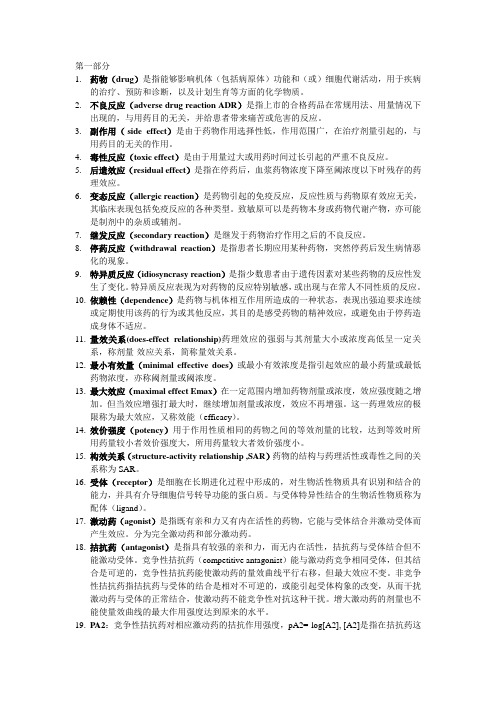
第一部分1.药物(drug)是指能够影响机体(包括病原体)功能和(或)细胞代谢活动,用于疾病的治疗、预防和诊断,以及计划生育等方面的化学物质。
2.不良反应(adverse drug reaction ADR)是指上市的合格药品在常规用法、用量情况下出现的,与用药目的无关,并给患者带来痛苦或危害的反应。
3.副作用( side effect)是由于药物作用选择性低,作用范围广,在治疗剂量引起的,与用药目的无关的作用。
4.毒性反应(toxic effect)是由于用量过大或用药时间过长引起的严重不良反应。
5.后遗效应(residual effect)是指在停药后,血浆药物浓度下降至阈浓度以下时残存的药理效应。
6.变态反应(allergic reaction)是药物引起的免疫反应,反应性质与药物原有效应无关,其临床表现包括免疫反应的各种类型。
致敏原可以是药物本身或药物代谢产物,亦可能是制剂中的杂质或辅剂。
7.继发反应(secondary reaction)是继发于药物治疗作用之后的不良反应。
8.停药反应(withdrawal reaction)是指患者长期应用某种药物,突然停药后发生病情恶化的现象。
9.特异质反应(idiosyncrasy reaction)是指少数患者由于遗传因素对某些药物的反应性发生了变化。
特异质反应表现为对药物的反应特别敏感,或出现与在常人不同性质的反应。
10.依赖性(dependence)是药物与机体相互作用所造成的一种状态,表现出强迫要求连续或定期使用该药的行为或其他反应,其目的是感受药物的精神效应,或避免由于停药造成身体不适应。
11.量效关系(does-effect relationship)药理效应的强弱与其剂量大小或浓度高低呈一定关系,称剂量-效应关系,简称量效关系。
12.最小有效量(minimal effective does)或最小有效浓度是指引起效应的最小药量或最低药物浓度,亦称阈剂量或阈浓度。
(完整版)药理学名词解释
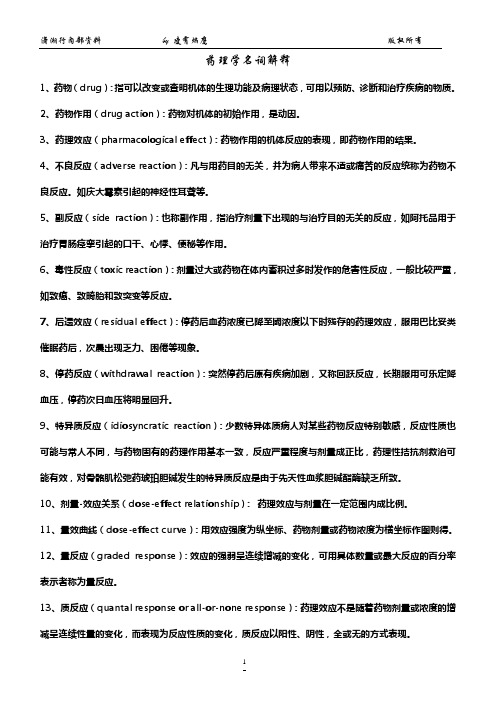
药理学名词解释1、药物(drug):指可以改变或查明机体的生理功能及病理状态,可用以预防、诊断和治疗疾病的物质。
2、药物作用(drug action):药物对机体的初始作用,是动因。
3、药理效应(pharmacological effect):药物作用的机体反应的表现,即药物作用的结果。
4、不良反应(adverse reaction):凡与用药目的无关,并为病人带来不适或痛苦的反应统称为药物不良反应。
如庆大霉素引起的神经性耳聋等。
5、副反应(side raction):也称副作用,指治疗剂量下出现的与治疗目的无关的反应,如阿托品用于治疗胃肠痉挛引起的口干、心悸、便秘等作用。
6、毒性反应(toxic reaction):剂量过大或药物在体内蓄积过多时发作的危害性反应,一般比较严重,如致癌、致畸胎和致突变等反应。
7、后遗效应(residual effect):停药后血药浓度已降至阈浓度以下时残存的药理效应,服用巴比妥类催眠药后,次晨出现乏力、困倦等现象。
8、停药反应(withdrawal reaction):突然停药后原有疾病加剧,又称回跃反应,长期服用可乐定降血压,停药次日血压将明显回升。
9、特异质反应(idiosyncratic reaction):少数特异体质病人对某些药物反应特别敏感,反应性质也可能与常人不同,与药物固有的药理作用基本一致,反应严重程度与剂量成正比,药理性拮抗剂救治可能有效,对骨骼肌松弛药琥珀胆碱发生的特异质反应是由于先天性血浆胆碱酯酶缺乏所致。
10、剂量-效应关系(dose-effect relationship):药理效应与剂量在一定范围内成比例。
11、量效曲线(dose-effect curve):用效应强度为纵坐标、药物剂量或药物浓度为横坐标作图则得。
12、量反应(graded response):效应的强弱呈连续增减的变化,可用具体数量或最大反应的百分率表示者称为量反应。
药理学完整英文名词解释
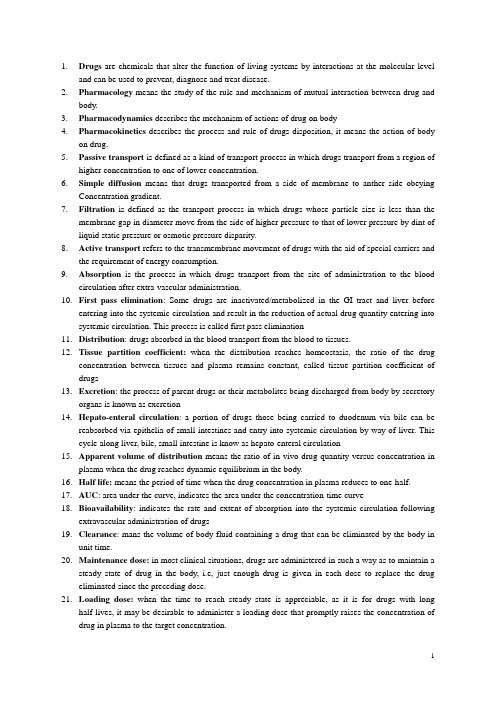
1.Drugs are chemicals that alter the function of living systems by interactions at the molecular leveland can be used to prevent, diagnose and treat disease.2.Pharmacology means the study of the rule and mechanism of mutual interaction between drug andbody.3.Pharmacodynamics describes the mechanism of actions of drug on body4.Pharmacokinetics describes the process and rule of drugs disposition, it means the action of bodyon drug.5.Passive transport is defined as a kind of transport process in which drugs transport from a region ofhigher concentration to one of lower concentration.6.Simple diffusion means that drugs transported from a side of membrane to anther side obeyingConcentration gradient.7.Filtration is defined as the transport process in which drugs whose particle size is less than themembrane gap in diameter move from the side of higher pressure to that of lower pressure by dint of liquid static pressure or osmotic pressure disparity.8.Active transport refers to the transmembrane movement of drugs with the aid of special carriers andthe requirement of energy consumption.9.Absorption is the process in which drugs transport from the site of administration to the bloodcirculation after extra-vascular administration.10.First pass elimination: Some drugs are inactivated/metabolized in the GI tract and liver beforeentering into the systemic circulation and result in the reduction of actual drug quantity entering into systemic circulation. This process is called first pass elimination11.Distribution: drugs absorbed in the blood transport from the blood to tissues.12.Tissue partition coefficient:when the distribution reaches homeostasis, the ratio of the drugconcentration between tissues and plasma remains constant, called tissue partition coefficient of drugs13.Excretion: the process of parent drugs or their metabolites being discharged from body by secretoryorgans is known as excretion14.Hepato-enteral circulation: a portion of drugs those being carried to duodenum via bile can bereabsorbed via epithelia of small intestines and entry into systemic circulation by way of liver. This cycle along liver, bile, small intestine is know as hepato-enteral circulation15.Apparent volume of distribution means the ratio of in vivo drug quantity versus concentration inplasma when the drug reaches dynamic equilibrium in the body.16.Half life: means the period of time when the drug concentration in plasma reduces to one-half.17.AUC: area under the curve, indicates the area under the concentration-time curve18.Bioavailability: indicates the rate and extent of absorption into the systemic circulation followingextravascular administration of drugs19.Clearance: mans the volume of body fluid containing a drug that can be eliminated by the body inunit time.20.Maintenance dose: in most clinical situations, drugs are administered in such a way as to maintain asteady state of drug in the body, i.e, just enough drug is given in each dose to replace the drug eliminated since the preceding dose.21.Loading dose:when the time to reach steady state is appreciable, as it is for drugs with longhalf-lives, it may be desirable to administer a loading dose that promptly raises the concentration of drug in plasma to the target concentration.22.Pharmacodynamics23.Drug action referred to the initial interaction between drug and body.24.Pharmacological effects is the physiological effects induced by drug action25.Stimulation: enhancement of the body function is Stimulation26.Inhibition: restraint or diminution of the body function is Inhibition27.Etiological therapy: Elimination of the etiological factors to cure diseases28.Symptomatic therapy: Improvement of disease symptom without eliminating the cause of thedisease29.Side reaction: In the range of therapeutic dosage, the drug effects, which are not related to thecurrent therapeutic purpose, are described as side effects.30.Toxic reaction can happened when the dose of the drug is high enough or drugs are long term used.31.Allergic reaction is a kind of response of the patient’s immuno-system to the antigen. It is not doserelated and only occur in a fraction of the population.32.Idiosyncratic reaction is the result of abnormal reactivity to a drug caused by genetic differences33.Secondary reaction results from long-term using of drug. Normal flora has been inhibited and theinsensitive flora becomes prominent34.Drug tolerance means the response to the same dose of a drug decreases with repeated uses.35.Physical dependence is an adaptive physiological state produced by repeated use of a drug. Oncedrug administration is stopped, abstinence syndromes will occur.36.Psychological dependence is the feeling of satisfaction and psychic drive that require periodic orcontinuous administration of the drug to produce a desired effect or to avoid discomfort .37.Graded response: In a certain range of doses, the pharmacological response increases with theincreasing of doses, such as blood pressure, muscle contraction, urinary excretion of sodium.38.Threshold dose indicates the least amount of drug needed to exert therapeutic, also as know asminimal effective dose39.Efficacy describes the maximal biological response produced by a drug40.Concentration for 50% of maximal effect (EC50): The concentration that give rise to 50% ofmaximal effect41.Potency is a term describing the comparative expression of a drug activity measured in terms of doserequired to produce a particular effect of given intensity related to a given standard reference.42.Quantal response: Indicate that a given dose of a drug has or has not evoked a certain effect in thevarious subjects under investigation.43.LD50: A dose that gives rise to the death of 50% of subjects is called LD5044.TI: therapeutic index. TI=LD50/ED50. It is a kind of index evaluated the safety of a drug.45.Receptor: A receptor can be defined as any biologic target macromolecule in cells that interactsspecifically with extracellular signal and converts it into intracellular effects46.Ligand:A ligand is a compound that binds to a receptor specially and produces the biologicalresponse. It was also called first messengers47.Down-regulation/Desensitization: Chronic stimulation of receptors can cause decreased numbers ofreceptors.48.Up-regulation/Hypersensitization: In contrary, chronic blocking receptors may result in receptorup-regulation49.Agonist can bind to receptors, then activate receptors and produce pharmacological effect.50.Antagonist: A pure antagonist, which can bind to receptors without intrinsic activity, antagonizes thebiologic effects of the corresponding agonist.51.Tolerance is said to develop when the response to the same dose of a drug decreases with repeateduses.52.Dependence means the body produce physiological or psychological dependence and requirement tosome drugs after long-term use of the drugs.53.Withdrawal syndrome Termination of some drugs using after long-term medication results inwithdrawal symptoms or withdrawal syndrome54.Cinchonism: It is described by the symptoms caused by toxicity of quinidine or quinine et al, thealkaloids extracted from cinchona, which include 3 major symptoms: gastrointestinal disturbance like vomiting, nausea, diarrhea; visual and aural disturbances as diplopia, photophobia, altered-color, hearing loss, tinnitus; and central nervous system effects like headache, confusion, psychosis.55.Mycardial remodeling: It is the most important intrinsic compensatory mechanism in CHF. It refersto the slow dilation and structural changes occurred in the stressed myocardium, including myocytes hypertrophy, proliferation of connective tissue cells (fibroblasts) and myocardial fibrosis. After an initial beneficial effect, mycardial remodeling can lead to ischemic changes, impairment of diastolic filling, and myocytes apoptosis. Angiotensin II and aldosterone can cause mycardial remodeling during CHF.56.First dose phenomenon: It refers to a precipitous drop in standing blood pressure, palpitation andsyncope shortly after the first dose of some antihypertensive drugs, especially prazosin.57.Thyroid storm(thyroid crisis): is sudden acute exacerbation of all of the symptoms ofthyrotoxicosis, presenting as a life-threatening syndrome.58.Insulin resistance:A diabetic requiring more than 200 units/day is regarded as insulin resistant.Acute resistant may result from the increase of anti-insulin factor-corticosteroids, growth hormone thyroxine, and estrogens. Chronic resistance may be due to a decline in number and/or affinity of receptors or to defects in post-receptor mechanisms.59.Hyperadrenalism-like syndrome: This is caused by lipid metabolism, and redistribution orwater-electrolyte metabolism disorders. The syndrome include moon faces, buffalo hump, central obesity, skin atrophy, acne, crinosity, edema, hypokalemia, hypertension, diabetes mellitus etc.60.Rebound phenomena: Discontinuing or repid extenuation of glucocorticosteriods can lead originaldiseases recurring or deteriorating.61.Superinfections : There is a complete microecosystem in health adult. After long-termusing broad-spectrum antibiotics, sensitive bacteria growth is inhibited, non- sensitive bacteria takes the chance of breeding, resulting in new infections.62.Chemotherapy:It is to use chemistry drugs treating or preventing the diseases caused bypathogenic microbe, helminth or cancer cell .63.Antibacterial drugs:substances to inhibit or kill bacteria and to prevent and cure the bacteroidalinflammation .64.Antibacterial spectrum:Antibacterial spectrum of a drug means the species of microorganismsthat the drug can inhibit or kill.65.antibacterial activity:It means the ability of a drug that the drug can inhibit or killmicroorganisms.66.Minimal inhibitory concentration (MIC):MIC is the lowest concentration of antimicrobial agentsthat prevents visible growth in 18-24 hours incubation.67.Minimal bactericidal concentration (MBC):MBC is the lowest concentration of antimicrobialagents that kills bacteria in culture medium.68.Chemotherapeutic index (CI):CI is a term used to evaluate the safety of chemotherapeuticdrugs.The value is LD50/ED50 or LD5/ED9569.Post - antibiotic effect , PAE:PAE shows the antimicrobial effect after the concentrationdecreased below MIC.70.Chemotherapy:It is to use chemistry drugs treating or preventing the diseases caused bypathogenic microbe, helminth or cancer cell .71.Chemotherapeutic index (CI):CI is a term used to evaluate the safety of chemotherapeuticdrugs.The value is LD50/ED50 or LD5/ED9572.Antibacterial drugs are substances to inhibit or kill bacteria and to prevent and cure the bacteroidalinflammation .73.Antibacterial spectrum of a drug means the species of microorganisms that the drug can inhibit orkill.74.antibacterial activity:It means the ability of a drug that the drug can inhibit or killmicroorganisms.75.Minimal inhibitory concentration (MIC):MIC is the lowest concentration of antimicrobial agentsthat prevents visible growth in 18-24 hours incubation.76.Minimal bactericidal concentration (MBC):MBC is the lowest concentration of antimicrobialagents that kills bacteria in culture medium.77.Post - antibiotic effect,PAE:shows the antimicrobial effect after the concentration decreased belowMIC78.Herxheimer reaction:it is caused by toxins released by the large number of dead spirocheteseliminated during the initial part of penicillin treatment . Some patients show symptoms of ague, fever, laryngeal pain, headache and tachycardia.79.Superinfections:There is a complete microecosystem in health adult. After long-term usingbroad-spectrum antibiotics, sensitive bacteria growth is inhibited, non- sensitive bacteria takes the chance of breeding, resulting in new infections.80.Tetracycline tooth:The Ca2+ in skeleton and the tooth that against fresh takes shape unites ,Createthe brown permanent pigmentation of permanent on tooth ,Enamel hypoplasia .Moreover repress the skeleton to develop ,The children are forbidden to use it.81.Cinchnism: That the dose may arouse a series of reactions is treatd by else alkaloids of quininealong with cinchona ,Express to disgusting 、Throw up 、Tinnitus 、Headache 、Hearing and sight go down, even temporary deaf.NSA: Medicines can be able to kill cancer cell of every stage in cell cycle, including G0 stagecancer cell.SA: Medicines is merely susceptible to one stage in cell cycle, insusceptible to G0 stage.。
药理学英文名词解释
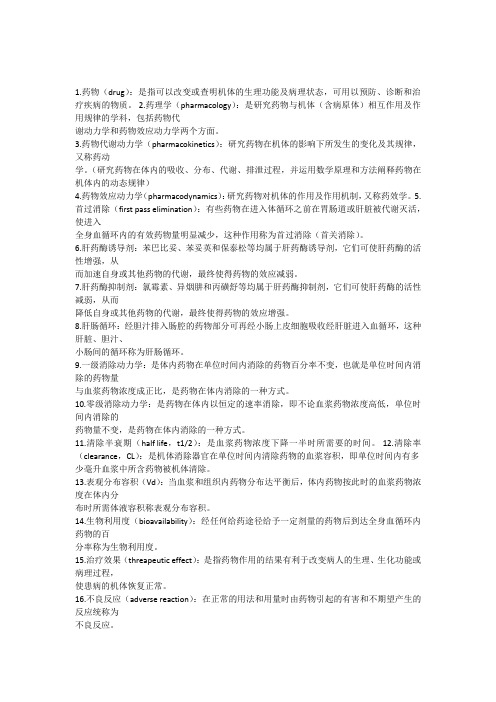
1.药物(drug):是指可以改变或查明机体的生理功能及病理状态,可用以预防、诊断和治疗疾病的物质。
2.药理学(pharmacology):是研究药物与机体(含病原体)相互作用及作用规律的学科,包括药物代谢动力学和药物效应动力学两个方面。
3.药物代谢动力学(pharmacokinetics):研究药物在机体的影响下所发生的变化及其规律,又称药动学。
(研究药物在体内的吸收、分布、代谢、排泄过程,并运用数学原理和方法阐释药物在机体内的动态规律)4.药物效应动力学(pharmacodynamics):研究药物对机体的作用及作用机制,又称药效学。
5.首过消除(first pass elimination):有些药物在进入体循环之前在胃肠道或肝脏被代谢灭活,使进入全身血循环内的有效药物量明显减少,这种作用称为首过消除(首关消除)。
6.肝药酶诱导剂:苯巴比妥、苯妥英和保泰松等均属于肝药酶诱导剂,它们可使肝药酶的活性增强,从而加速自身或其他药物的代谢,最终使得药物的效应减弱。
7.肝药酶抑制剂:氯霉素、异烟肼和丙磺舒等均属于肝药酶抑制剂,它们可使肝药酶的活性减弱,从而降低自身或其他药物的代谢,最终使得药物的效应增强。
8.肝肠循环:经胆汁排入肠腔的药物部分可再经小肠上皮细胞吸收经肝脏进入血循环,这种肝脏、胆汁、小肠间的循环称为肝肠循环。
9.一级消除动力学:是体内药物在单位时间内消除的药物百分率不变,也就是单位时间内消除的药物量与血浆药物浓度成正比,是药物在体内消除的一种方式。
10.零级消除动力学:是药物在体内以恒定的速率消除,即不论血浆药物浓度高低,单位时间内消除的药物量不变,是药物在体内消除的一种方式。
11.清除半衰期(half life,t1/2):是血浆药物浓度下降一半时所需要的时间。
12.清除率(clearance,CL):是机体消除器官在单位时间内清除药物的血浆容积,即单位时间内有多少毫升血浆中所含药物被机体清除。
药理学名词解释中英文

Pharmacology
主要研究药物与机体(包括病原体)相互作用规律和机制的科学
Pharmacodynamic
研究药物对机体的作用及其机制
Pharmacokinetics
研究机体对药物的作用,即药物在体内的吸收、分布、代谢、排泄及其动态变化的规律。
Bioavailability
药物吸收的速度和程度,即药物由给药部位到达体循环的量
Abstinence syndrome戒断综合征
由于反复用药所造成的一种适应转态,中断用药会可产生一种强烈的躯体发面的损害即为戒断综合症
Addiction
精神依赖性是使人产生一种要周期性连续地用药欲望,产生强迫性用药行为,以满足或避免不适感,也称成瘾
Drug interaction
同时使用两种或两种以上的药物时候,其中一个药物收到另外一个药物的影响而发挥明显的改变,称药物相互作用
Reye’s syndrome瑞夷综合症
儿童感染病毒性疾病如流感、水痘、麻疹、流行性腮腺炎等使用阿司匹林退热使时,偶见引起急性肝脂肪变性-脑病综合症
Arrhythmia心律失常
是指心脏冲动频率、节律、起源部位、传导速度和传导顺序等发生异常
Action potential,AP动作电位
心细胞兴奋时,膜两侧离子跨膜转运,细胞两侧电位发生变化,形成动作电位
Depressive disorder抑郁障碍
是一种常见的情感障碍性疾病
Analgesics镇痛药
是一类主要作用与中枢神经系统特定部位,选择性减轻或消除疼痛及疼痛引起的烦躁不安等不愉快情绪,但不影响意识及其他感觉的药物
非甾体抗炎药NSAIDs
一类具有解热、镇痛作用的药物,而且大多数还具有抗炎、抗风湿作用
药理学的英语名词解释
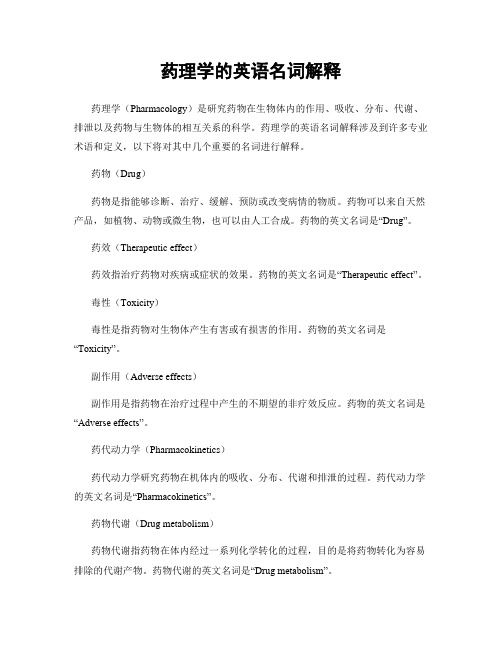
药理学的英语名词解释药理学(Pharmacology)是研究药物在生物体内的作用、吸收、分布、代谢、排泄以及药物与生物体的相互关系的科学。
药理学的英语名词解释涉及到许多专业术语和定义,以下将对其中几个重要的名词进行解释。
药物(Drug)药物是指能够诊断、治疗、缓解、预防或改变病情的物质。
药物可以来自天然产品,如植物、动物或微生物,也可以由人工合成。
药物的英文名词是“Drug”。
药效(Therapeutic effect)药效指治疗药物对疾病或症状的效果。
药物的英文名词是“Therapeutic effect”。
毒性(Toxicity)毒性是指药物对生物体产生有害或有损害的作用。
药物的英文名词是“Toxicity”。
副作用(Adverse effects)副作用是指药物在治疗过程中产生的不期望的非疗效反应。
药物的英文名词是“Adverse effects”。
药代动力学(Pharmacokinetics)药代动力学研究药物在机体内的吸收、分布、代谢和排泄的过程。
药代动力学的英文名词是“Pharmacokinetics”。
药物代谢(Drug metabolism)药物代谢指药物在体内经过一系列化学转化的过程,目的是将药物转化为容易排除的代谢产物。
药物代谢的英文名词是“Drug metabolism”。
药物排泄(Drug excretion)药物排泄是指药物通过肾脏、肝脏、肺部等途径从机体中排出的过程。
药物排泄的英文名词是“Drug excretion”。
药物相互作用(Drug interactions)药物相互作用是指两种或更多药物在体内相遇时互相影响、相互作用的过程。
药物相互作用的英文名词是“Drug interactions”。
药物治疗(Drug therapy)药物治疗是使用药物来治疗疾病或症状的方法。
药物治疗的英文名词是“Drug therapy”。
临床试验(Clinical trials)临床试验是指在人体上进行的旨在评估药物安全性、疗效和副作用的研究。
医学药理学英文名词解释

医学药理学英文名词解释absorption吸收:是指药物从给药部位进入;adrenalinereversal肾上腺素升压;Adrenoceptorag.肾上腺素受体激动药;adversereaction不良反应:是指上市;Afterdepol.后除极:一个动作电位中0相;aftereffect后效应:指细菌接触抗生素后;agonist激动药:是指既有亲和力又有内在活性;allerabsorption吸收:是指药物从给药部位进入血液循环的过程。
adrenaline reversal肾上腺素升压作用的翻转:a受体阻断药酚妥拉明等可取消去氧肾上腺素的升压作用,可以部分阻断去氧肾上腺素所致升高血压作用,使肾上腺素的升压作用翻转为降压作用,称为肾上腺素升压作用的翻转。
Adrenoceptor ag.肾上腺素受体激动药:一类化学结构与药理作用和肾上腺素、去甲肾上腺素相似的药物,与肾上腺受体结合后激动受体,产生肾上腺素样作用,又称拟肾上腺素药。
adverse reaction不良反应:是指上市的合格药品在常规用法、用量情况下出现的,与用药目的无关,并给患者带来痛苦或危害的反应。
Afterdepol.后除极:一个动作电位中0相除极后发生的除极,其频率较快、振幅较小,频荡性波动,膜电位不稳定,易引起异常冲动。
根据时间分为早后除极和晚后除极。
after effect后效应:指细菌接触抗生素后,当药物消除或浓度降到最低抑菌浓度以下时,细菌的生长在一段时间内仍受持续抑制的效应。
agonist激动药:是指既有亲和力又有内在活性的药物,它能与受体结合并激动受体而产生效应。
分为完全激动药和部分激动药。
allergic reaction变态反应:是药物引起的免疫反应,反应性质与药物原有效应无关,其临床表现包括免疫反应的各种类型。
致敏原可以是药物本身或药物代谢产物,亦可能是制剂中的杂质或辅剂。
antagonist拮抗药:是指具有较强的亲和力,而无内在活性,拮抗药与受体结合但不能激动受体。
药理专业名词中英文对照

药理专业名词中英文对照药理学是一个专业的领域,主要研究药物的作用、剂量、药效以及在人体内的代谢和排泄。
在药理学这一领域中,有许多专业名词需要掌握。
本文将为大家提供药理专业名词的中英文对照。
1. 药物代谢(Drug Metabolism)药物代谢是指药物在人体内的化学转化过程。
药物代谢通常被分为两种方式:肝脏代谢和肠道代谢。
药物代谢的产物可以是活性的,也可以是非活性的,因此这个过程对于人体吸收药物的效果有着重要的影响。
2. 药效学(Pharmacodynamics)药效学主要研究药物的药效(也被称为药理作用)。
药效通常是药物与人体发生交互作用的结果。
药物的药效可以是治疗作用、副作用或者毒性作用。
3. 药物给药(Drug Administration)药物给药是指药物在人体内的途径。
常见的药物给药方式包括口服、注射、吸入和外用等。
4. 药物吸收(Drug Absorption)药物吸收是指药物从给药部位进入到人体血液中的过程。
药物可以通过口服、注射等方式进行吸收。
5. 药物分布(Drug Distribution)药物分布是指药物在人体内的分布情况。
药物可以通过血液、组织液和细胞膜渗透等途径进行分布。
6. 药物排泄(Drug Excretion)药物排泄是指药物从人体内被排除的过程。
药物可以通过肝脏、肾脏、肠道和肺部等途径进行排泄。
7. 药物代数学(Pharmacokinetics)药物代数学主要研究药物在人体内的吸收、分布、代谢和排泄过程。
药物代数学可以帮助我们更好地理解药物的药效、剂量以及毒性等方面。
8. 半衰期(Half-life)半衰期是指药物从人体内消失一半的时间。
药物的半衰期可以反映药物在人体内的代谢速度以及药物的剂量等因素。
9. 毒性(Toxicity)毒性是指药物对于人体的有害影响。
毒性可以是急性的、亚急性的或者慢性的。
药物的毒性可以影响人体的正常生理活动,甚至会导致死亡。
10. 剂量(Dosage)剂量是指药物的给药量。
药理学名词解释(含英文)

药理学名词解释第一篇总论第一章绪言1. 药物(drug)用于治疗、预防、诊断疾病的化学物质。
2. 药理学(pharmacology)研究药物与机体or病原体相互作用的规律和原理的一门学科。
3. 药效动力学(pharmacodynamics)药效学,研究药物对机体的作用及其作用机制,阐明药物防治疾病的规律。
4. 药代动力学(pharmacokinetics)药动学,研究机体对药物的处置的动态变化,特别是血药浓度随时间变化的规律。
5. 发现新药根据实验药物的来源,运用各种技术手段,充分了解未知化合物的药理作用及特点。
6. 评价新药经过科学、严格的实验设计,并与已上市的公认的有效药物进行比较,客观评价有效化合物的优劣,从而决定取舍。
7. 一般药理学研究对新药主要药效作用以外的广泛药理作用进行研究。
8. 毒理学(toxicology)研究外源性物质对机体伤害作用的科学。
第二章药效学1. 药物作用(drug action)药物与机体组织间的原发作用。
2. 药物效应(drug effect)药物原发作用所引起的机体器官原有功能的改变。
3. 兴奋(excitation)能使机体生理、生化功能加强的作用。
4. 抑制(inhibition)引起功能活动减弱的作用。
5. 局部作用(local action)药物无需经过吸收、而在用药部位发挥的直接作用。
6. 全身作用(general action)吸收作用、系统作用,药物通过吸收经血液循环而分布到机体有关部位发挥的作用。
7. 治疗作用(therapeutic action)能达到防治效果的作用。
8. 对因治疗(etiological treatment)治本,针对病因治疗。
9. 对症治疗(symptomatic treatment)治标,改善疾病症状,但不能消除病因。
10. 副作用(side effect)副反应,用治疗量的药物后出现的与治疗无关的不适反应。
11. 毒性反应(toxic reaction)用药剂量过大or用药时间过长而引起的不良反应。
药理学完整英文名词解释
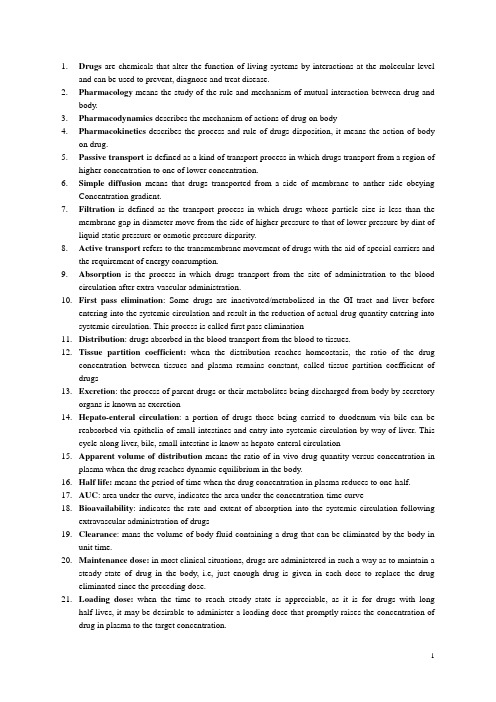
1.Drugs are chemicals that alter the function of living systems by interactions at the molecular leveland can be used to prevent, diagnose and treat disease.2.Pharmacology means the study of the rule and mechanism of mutual interaction between drug andbody.3.Pharmacodynamics describes the mechanism of actions of drug on body4.Pharmacokinetics describes the process and rule of drugs disposition, it means the action of bodyon drug.5.Passive transport is defined as a kind of transport process in which drugs transport from a region ofhigher concentration to one of lower concentration.6.Simple diffusion means that drugs transported from a side of membrane to anther side obeyingConcentration gradient.7.Filtration is defined as the transport process in which drugs whose particle size is less than themembrane gap in diameter move from the side of higher pressure to that of lower pressure by dint of liquid static pressure or osmotic pressure disparity.8.Active transport refers to the transmembrane movement of drugs with the aid of special carriers andthe requirement of energy consumption.9.Absorption is the process in which drugs transport from the site of administration to the bloodcirculation after extra-vascular administration.10.First pass elimination: Some drugs are inactivated/metabolized in the GI tract and liver beforeentering into the systemic circulation and result in the reduction of actual drug quantity entering into systemic circulation. This process is called first pass elimination11.Distribution: drugs absorbed in the blood transport from the blood to tissues.12.Tissue partition coefficient:when the distribution reaches homeostasis, the ratio of the drugconcentration between tissues and plasma remains constant, called tissue partition coefficient of drugs13.Excretion: the process of parent drugs or their metabolites being discharged from body by secretoryorgans is known as excretion14.Hepato-enteral circulation: a portion of drugs those being carried to duodenum via bile can bereabsorbed via epithelia of small intestines and entry into systemic circulation by way of liver. This cycle along liver, bile, small intestine is know as hepato-enteral circulation15.Apparent volume of distribution means the ratio of in vivo drug quantity versus concentration inplasma when the drug reaches dynamic equilibrium in the body.16.Half life: means the period of time when the drug concentration in plasma reduces to one-half.17.AUC: area under the curve, indicates the area under the concentration-time curve18.Bioavailability: indicates the rate and extent of absorption into the systemic circulation followingextravascular administration of drugs19.Clearance: mans the volume of body fluid containing a drug that can be eliminated by the body inunit time.20.Maintenance dose: in most clinical situations, drugs are administered in such a way as to maintain asteady state of drug in the body, i.e, just enough drug is given in each dose to replace the drug eliminated since the preceding dose.21.Loading dose:when the time to reach steady state is appreciable, as it is for drugs with longhalf-lives, it may be desirable to administer a loading dose that promptly raises the concentration of drug in plasma to the target concentration.22.Pharmacodynamics23.Drug action referred to the initial interaction between drug and body.24.Pharmacological effects is the physiological effects induced by drug action25.Stimulation: enhancement of the body function is Stimulation26.Inhibition: restraint or diminution of the body function is Inhibition27.Etiological therapy: Elimination of the etiological factors to cure diseases28.Symptomatic therapy: Improvement of disease symptom without eliminating the cause of thedisease29.Side reaction: In the range of therapeutic dosage, the drug effects, which are not related to thecurrent therapeutic purpose, are described as side effects.30.Toxic reaction can happened when the dose of the drug is high enough or drugs are long term used.31.Allergic reaction is a kind of response of the patient’s immuno-system to the antigen. It is not doserelated and only occur in a fraction of the population.32.Idiosyncratic reaction is the result of abnormal reactivity to a drug caused by genetic differences33.Secondary reaction results from long-term using of drug. Normal flora has been inhibited and theinsensitive flora becomes prominent34.Drug tolerance means the response to the same dose of a drug decreases with repeated uses.35.Physical dependence is an adaptive physiological state produced by repeated use of a drug. Oncedrug administration is stopped, abstinence syndromes will occur.36.Psychological dependence is the feeling of satisfaction and psychic drive that require periodic orcontinuous administration of the drug to produce a desired effect or to avoid discomfort .37.Graded response: In a certain range of doses, the pharmacological response increases with theincreasing of doses, such as blood pressure, muscle contraction, urinary excretion of sodium.38.Threshold dose indicates the least amount of drug needed to exert therapeutic, also as know asminimal effective dose39.Efficacy describes the maximal biological response produced by a drug40.Concentration for 50% of maximal effect (EC50): The concentration that give rise to 50% ofmaximal effect41.Potency is a term describing the comparative expression of a drug activity measured in terms of doserequired to produce a particular effect of given intensity related to a given standard reference.42.Quantal response: Indicate that a given dose of a drug has or has not evoked a certain effect in thevarious subjects under investigation.43.LD50: A dose that gives rise to the death of 50% of subjects is called LD5044.TI: therapeutic index. TI=LD50/ED50. It is a kind of index evaluated the safety of a drug.45.Receptor: A receptor can be defined as any biologic target macromolecule in cells that interactsspecifically with extracellular signal and converts it into intracellular effects46.Ligand:A ligand is a compound that binds to a receptor specially and produces the biologicalresponse. It was also called first messengers47.Down-regulation/Desensitization: Chronic stimulation of receptors can cause decreased numbers ofreceptors.48.Up-regulation/Hypersensitization: In contrary, chronic blocking receptors may result in receptorup-regulation49.Agonist can bind to receptors, then activate receptors and produce pharmacological effect.50.Antagonist: A pure antagonist, which can bind to receptors without intrinsic activity, antagonizes thebiologic effects of the corresponding agonist.51.Tolerance is said to develop when the response to the same dose of a drug decreases with repeateduses.52.Dependence means the body produce physiological or psychological dependence and requirement tosome drugs after long-term use of the drugs.53.Withdrawal syndrome Termination of some drugs using after long-term medication results inwithdrawal symptoms or withdrawal syndrome54.Cinchonism: It is described by the symptoms caused by toxicity of quinidine or quinine et al, thealkaloids extracted from cinchona, which include 3 major symptoms: gastrointestinal disturbance like vomiting, nausea, diarrhea; visual and aural disturbances as diplopia, photophobia, altered-color, hearing loss, tinnitus; and central nervous system effects like headache, confusion, psychosis.55.Mycardial remodeling: It is the most important intrinsic compensatory mechanism in CHF. It refersto the slow dilation and structural changes occurred in the stressed myocardium, including myocytes hypertrophy, proliferation of connective tissue cells (fibroblasts) and myocardial fibrosis. After an initial beneficial effect, mycardial remodeling can lead to ischemic changes, impairment of diastolic filling, and myocytes apoptosis. Angiotensin II and aldosterone can cause mycardial remodeling during CHF.56.First dose phenomenon: It refers to a precipitous drop in standing blood pressure, palpitation andsyncope shortly after the first dose of some antihypertensive drugs, especially prazosin.57.Thyroid storm(thyroid crisis): is sudden acute exacerbation of all of the symptoms ofthyrotoxicosis, presenting as a life-threatening syndrome.58.Insulin resistance:A diabetic requiring more than 200 units/day is regarded as insulin resistant.Acute resistant may result from the increase of anti-insulin factor-corticosteroids, growth hormone thyroxine, and estrogens. Chronic resistance may be due to a decline in number and/or affinity of receptors or to defects in post-receptor mechanisms.59.Hyperadrenalism-like syndrome: This is caused by lipid metabolism, and redistribution orwater-electrolyte metabolism disorders. The syndrome include moon faces, buffalo hump, central obesity, skin atrophy, acne, crinosity, edema, hypokalemia, hypertension, diabetes mellitus etc.60.Rebound phenomena: Discontinuing or repid extenuation of glucocorticosteriods can lead originaldiseases recurring or deteriorating.61.Superinfections : There is a complete microecosystem in health adult. After long-termusing broad-spectrum antibiotics, sensitive bacteria growth is inhibited, non- sensitive bacteria takes the chance of breeding, resulting in new infections.62.Chemotherapy:It is to use chemistry drugs treating or preventing the diseases caused bypathogenic microbe, helminth or cancer cell .63.Antibacterial drugs:substances to inhibit or kill bacteria and to prevent and cure the bacteroidalinflammation .64.Antibacterial spectrum:Antibacterial spectrum of a drug means the species of microorganismsthat the drug can inhibit or kill.65.antibacterial activity:It means the ability of a drug that the drug can inhibit or killmicroorganisms.66.Minimal inhibitory concentration (MIC):MIC is the lowest concentration of antimicrobial agentsthat prevents visible growth in 18-24 hours incubation.67.Minimal bactericidal concentration (MBC):MBC is the lowest concentration of antimicrobialagents that kills bacteria in culture medium.68.Chemotherapeutic index (CI):CI is a term used to evaluate the safety of chemotherapeuticdrugs.The value is LD50/ED50 or LD5/ED9569.Post - antibiotic effect , PAE:PAE shows the antimicrobial effect after the concentrationdecreased below MIC.70.Chemotherapy:It is to use chemistry drugs treating or preventing the diseases caused bypathogenic microbe, helminth or cancer cell .71.Chemotherapeutic index (CI):CI is a term used to evaluate the safety of chemotherapeuticdrugs.The value is LD50/ED50 or LD5/ED9572.Antibacterial drugs are substances to inhibit or kill bacteria and to prevent and cure the bacteroidalinflammation .73.Antibacterial spectrum of a drug means the species of microorganisms that the drug can inhibit orkill.74.antibacterial activity:It means the ability of a drug that the drug can inhibit or killmicroorganisms.75.Minimal inhibitory concentration (MIC):MIC is the lowest concentration of antimicrobial agentsthat prevents visible growth in 18-24 hours incubation.76.Minimal bactericidal concentration (MBC):MBC is the lowest concentration of antimicrobialagents that kills bacteria in culture medium.77.Post - antibiotic effect,PAE:shows the antimicrobial effect after the concentration decreased belowMIC78.Herxheimer reaction:it is caused by toxins released by the large number of dead spirocheteseliminated during the initial part of penicillin treatment . Some patients show symptoms of ague, fever, laryngeal pain, headache and tachycardia.79.Superinfections:There is a complete microecosystem in health adult. After long-term usingbroad-spectrum antibiotics, sensitive bacteria growth is inhibited, non- sensitive bacteria takes the chance of breeding, resulting in new infections.80.Tetracycline tooth:The Ca2+ in skeleton and the tooth that against fresh takes shape unites ,Createthe brown permanent pigmentation of permanent on tooth ,Enamel hypoplasia .Moreover repress the skeleton to develop ,The children are forbidden to use it.81.Cinchnism: That the dose may arouse a series of reactions is treatd by else alkaloids of quininealong with cinchona ,Express to disgusting 、Throw up 、Tinnitus 、Headache 、Hearing and sight go down, even temporary deaf.NSA: Medicines can be able to kill cancer cell of every stage in cell cycle, including G0 stagecancer cell.SA: Medicines is merely susceptible to one stage in cell cycle, insusceptible to G0 stage.。
- 1、下载文档前请自行甄别文档内容的完整性,平台不提供额外的编辑、内容补充、找答案等附加服务。
- 2、"仅部分预览"的文档,不可在线预览部分如存在完整性等问题,可反馈申请退款(可完整预览的文档不适用该条件!)。
- 3、如文档侵犯您的权益,请联系客服反馈,我们会尽快为您处理(人工客服工作时间:9:00-18:30)。
医学药理学英文名词解释absorption吸收:是指药物从给药部位进入;adrenalinereversal肾上腺素升压;Adrenoceptorag.肾上腺素受体激动药;adversereaction不良反应:是指上市;Afterdepol.后除极:一个动作电位中0相;aftereffect后效应:指细菌接触抗生素后;agonist激动药:是指既有亲和力又有内在活性;allerabsorption吸收:是指药物从给药部位进入血液循环的过程。
adrenaline reversal肾上腺素升压作用的翻转:a受体阻断药酚妥拉明等可取消去氧肾上腺素的升压作用,可以部分阻断去氧肾上腺素所致升高血压作用,使肾上腺素的升压作用翻转为降压作用,称为肾上腺素升压作用的翻转。
Adrenoceptor ag.肾上腺素受体激动药:一类化学结构与药理作用和肾上腺素、去甲肾上腺素相似的药物,与肾上腺受体结合后激动受体,产生肾上腺素样作用,又称拟肾上腺素药。
adverse reaction不良反应:是指上市的合格药品在常规用法、用量情况下出现的,与用药目的无关,并给患者带来痛苦或危害的反应。
Afterdepol.后除极:一个动作电位中0相除极后发生的除极,其频率较快、振幅较小,频荡性波动,膜电位不稳定,易引起异常冲动。
根据时间分为早后除极和晚后除极。
after effect后效应:指细菌接触抗生素后,当药物消除或浓度降到最低抑菌浓度以下时,细菌的生长在一段时间内仍受持续抑制的效应。
agonist激动药:是指既有亲和力又有内在活性的药物,它能与受体结合并激动受体而产生效应。
分为完全激动药和部分激动药。
allergic reaction变态反应:是药物引起的免疫反应,反应性质与药物原有效应无关,其临床表现包括免疫反应的各种类型。
致敏原可以是药物本身或药物代谢产物,亦可能是制剂中的杂质或辅剂。
antagonist拮抗药:是指具有较强的亲和力,而无内在活性,拮抗药与受体结合但不能激动受体。
antibacterual spectrum抗菌谱:指抗菌药物的抗菌作用范围。
antibacterual activity抗菌活性:是指抗菌药物抑制或杀灭病原菌的能力,这是由于各种病原菌或者同一菌种的不同菌株对同一种抗菌药的敏感性不同的关系。
aspirin asthma阿司匹林哮喘:有些哮喘患者服用阿司匹林或某些解热镇痛药后可诱发支气管哮喘,称为“阿司匹林哮喘”。
bacteriostatic drugs抗菌药:是指某种或某一类抗菌药物仅具有抑制病原菌生长繁殖的能力而无杀灭作用。
bactericidal drugs杀菌药:该类抗菌药物不但具有抑制病原菌生长繁殖的能力,而且具有杀灭的作用。
bacterial resistance细菌耐药性:是指病原菌对抗菌药物敏感性下降甚至消失的现象,这种病原菌称为耐药菌,造成抗菌药物对耐药菌感染的临床疗效降低或者无效。
blood-brain barrier,BBB血脑屏障:指由脑毛细血管形成的血浆与脑细胞外液间的屏障以及由脉络膜形成的血浆与脑脊液间的屏障。
bioavailability 生物利用度:是指药物从某制剂吸收进入血液循环的相对数量和速度。
是评价药物制剂质量的一个重要指标。
分为绝对生物利用度和相对生物利用度。
chemotherapeutic index, CI化疗指数:是评价包括化学治疗药物在内的所有化学治疗药物有效性与安全性的重要指标,常以LD50/ED50或LD5/ED95,这一比列关系来衡量,这一比例关系称为化疗指数。
化疗指数愈大,表明该化疗药物的治疗效果越好;而对机体的毒性越小,则临床应用价值越高。
chichonic reaction金鸡纳反应:病人使用奎尼丁后,表现为头痛、头晕、耳鸣、腹泻、恶心、视物模糊等症状,称为金鸡纳反应。
cholinergic risk胆碱能危象:抗胆碱酯酶药如新斯的明治疗重症肌无力,因应用过量可使骨骼肌运动终板处有过多乙酰胆碱堆积,导致持久去极化,加重神经肌肉传递功能障碍,使肌无力症状加重,称为胆碱能危象。
competitive antagonist竞争性拮抗药:能与激动药竞争相同受体,但其结合是可逆的,竞争性拮抗药能使激动药的量效曲线平行右移,但最大效应不变。
dawn phenomenon黎明现象:糖尿病患者凌晨3-9时血糖明显升高的现象,是因胰岛素分泌不足或用量不足,午夜后升糖激素分泌增加,使血糖升高的现象,呈“高后高”的特征。
delayed afterdep. DAD迟后去极:在细胞内钙超载情况下,发生在动作电位完全或接近完全复极时的一种短暂的振荡性去极。
dependence依赖性:是药物与机体相互作用所造成的一种状态,表现出强迫要求连续或定期使用该药的行为或其他反应,其目的是感受药物的精神效应,或避免由于停药造成身体不适应。
does-effect relationship效量关系:药理效应的强弱与其剂量大小或浓度高低呈一定关系,称剂量-效应关系。
Drngresistance耐药性:长期应用化疗药物后,病原体对药物产生的耐受性。
drug药物:是指能够影响机体功能和细胞代谢活动,用于疾病的治疗、预防和诊断,以及计划生育等方面的化学物质。
early afterdepolarization早后去极:发生在完全复极之前的后去极,常见于2、3相复极中,因膜电位不稳定而产生的振荡。
ED50 半数有效量:能引起50%动物或实验标本产生反应的浓度或剂量。
Elimination药物的消除:药物因分布、代谢、排泄而自血液或机体的清除。
enzyme inducer药酶诱导剂:凡能诱导药酶活性增加或加速药酶合成的药物称为药酶诱导剂, 肝药酶可以受到某些药物的诱导而活性增加,如苯巴比妥。
first order elimination kinetics一级消除动力学:是指血中药物消除速率与血中药物浓度的一次方成正比,即血药浓度高,单位时间内消除的药量多;血药浓度低,单位时间内消除的药量少。
first-pass effect首关效应:是指某些药物首次通过肠壁或经门静脉进入肝脏时被其中的酶所代谢致使进入体循环药量减少的一种现象。
half-life,t1/2半衰期:指血浆消除半衰期,是药物在体内分布达到平衡状态后血浆药物浓度降低一半所需的时间,是表述药物在体内消除快慢的重要参数。
Hepo-enteral cir.肝肠循环:由胆汁排入十二指肠的药物有的直接随粪便排出,但较多的药物可由小肠上皮吸收,并经肝脏重新进入全身循环,这种肝脏、胆汁间、小肠的循环称为肝肠循环。
idiosyncrasy reaction特异质反应:是指少数患者由于遗传因素对某些药物的反应性发生了变化。
特异质反应表现为对药物的反应特别敏感,或出现与在常人不同性质的反应。
Ion cha.离子通道:是细胞膜中的跨膜蛋白质分子,对某些离子能选择性通透,是生物电活动的基础。
Loading dose 负荷剂量:为了使血药浓度迅速达到所需要的水平,在常规给药前应用的一次剂量。
maximal effect最大效应:在一定范围内增加药物剂量或浓度,效应强度随之增加。
但当效应增强打最大时,继续增加剂量或浓度,效应不再增强。
这一药理效应的极限称为最大效应,又称效能。
MBC最低杀菌浓度:在体外实验中,药物能够杀灭培养基内细菌生长的最低浓度。
Membrane res.膜反应性:指膜电位水平与其激发的0相最大上升速率之间的关系。
膜电位高,0相上升速率快,动作电位振幅大,传导速度快。
MIC最低抑菌浓度:在体外实验中,药物能够抑制培养基内细菌生长的最低浓度。
minimal effective does最小有效量:或最小有效浓度是指引起效应的最小药量或最低药物浓度,亦称阈剂量或阈浓度。
minimal inhibitory con, MIC最低抑菌浓度:在体外实验中,能抑制培养基内病原菌生长的最低药物浓度,称为最低抑菌浓度。
minimal bactericidal con, MBC最低杀菌浓度:在体外实验中,能够杀灭培养基内细菌或使细菌数减少99.9%的最低药物浓度,称为最低杀菌浓度。
minimum alveolar concentration, MAC最小肺泡药物浓度:是指在一个大气压下,使50%患者或动物对伤害性刺激不再产生体动反应(逃避反射)时呼气末潮气(相当于肺泡气)内麻醉药浓度,单位是Vol %,MAC越小,麻醉药的效价越高。
multidrug resistance多药耐药性:指肿瘤细胞与某一抗肿瘤药物接触后,除对其产生耐药性外,还对其他多种结构不同且作用机制各异的抗肿瘤药物产生耐药性,即所谓的交叉耐药现象。
Nervous tran.神经递质:神经元与下一级神经元或效应器之间通过释放传递信息的化学物质。
on-off phenomenon “开-关”现象:患者服用左旋多巴后突然发生的少动(肌强直性运动不能,即“关”),此现象持续数分钟或数小时后,又突然自动恢复为良好状态,但常伴有PA2:竞争性拮抗药对相应激动药的拮抗作用强度,pA2=-log[A2], [A2]是指在拮抗药这一浓度下,可使激动药在2倍浓度使所产生的效应恰好等于未加入拮抗药时激动药引起的效应。
PAE抗菌后效应:指细菌与抗生素短暂接触,当药物浓度下降低于最低抑菌浓度或消除后,细菌的生长不能恢复正常。
pD2:药物-受体复合物解离常数KD的负对数(-logKD)为pD2,其值与A和R的亲和力成正比。
意义是引起最大效应的一半时(即50%受体被占领时)所需的药物浓度。
Pharmacology药理学:研究药物与机体作用规律及原理的科学,为临床合理用药提供基础。
Pha.mics药物效应动力学:研究药物对机体的作用及作用原理。
Pha.tics药物代谢动力学:研究药物的体内过程及体内药物浓度随时间变化的规律。
Placebo 安慰剂:无药理活性的剂型。
post antibiotic effect, PAE抗生素后效应:指抗生素或抗菌药物作用于细菌一定时间撤药后,血药浓度已低于MIC时,细菌生长繁殖受抑制的作用仍可持续一段时间,此现象称为抗生素后效应。
Potency in.效价强度:用于作用性质相同的药物之间的等效剂量的比较,达到等效时所用药量较小者效价强度大,所用药量较大者效价强度小。
receptor受体:是细胞在长期进化过程中形成的,对生物活性物质具有识别和结合的能力,并具有介导细胞信号转导功能的蛋白质。
与受体特异性结合的生物活性物质称为配体。
reentrant ex.折返激动reentry:是指一次冲动下传后,又可顺着另一环形通路折回再次兴奋原已兴奋过的心肌,是引起快速型心律失常的重要机制之一。
